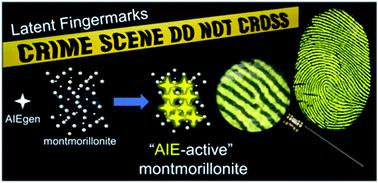当前位置:
X-MOL 学术
›
Mater. Chem. Front.
›
论文详情
Our official English website, www.x-mol.net, welcomes your feedback! (Note: you will need to create a separate account there.)
Development of AIEgen–montmorillonite nanocomposite powders for computer-assisted visualization of latent fingermarks
Materials Chemistry Frontiers ( IF 7 ) Pub Date : 2020-05-25 , DOI: 10.1039/d0qm00059k Jiawei Li 1, 2, 3, 4, 5 , Zhe Jiao 5, 6, 7, 8, 9 , Pengfei Zhang 8, 9, 10, 11, 12 , Xuejuan Wan 1, 2, 3, 4 , Chao Song 8, 13, 14, 15, 16 , Zongning Guo 8, 17, 18 , Xuelin Huang 8, 17, 18 , Ben Zhong Tang 19, 20, 21, 22, 23
Materials Chemistry Frontiers ( IF 7 ) Pub Date : 2020-05-25 , DOI: 10.1039/d0qm00059k Jiawei Li 1, 2, 3, 4, 5 , Zhe Jiao 5, 6, 7, 8, 9 , Pengfei Zhang 8, 9, 10, 11, 12 , Xuejuan Wan 1, 2, 3, 4 , Chao Song 8, 13, 14, 15, 16 , Zongning Guo 8, 17, 18 , Xuelin Huang 8, 17, 18 , Ben Zhong Tang 19, 20, 21, 22, 23
Affiliation

|
The forensic analysis of fingerprints is widely used to identify criminals and has become the basis of court evidence. In the work described in this paper, a new composite was developed for latent fingerprint (LFP) imaging; this composite was made by combining the aggregation-induced emission luminogen (AIEgen) salicylaldehyde azine (SAA) with montmorillonite (MMT). Gray value analysis and pattern recognition analysis based on MATLAB were conducted to evaluate the quality of the obtained LFP in comparison with the reference fingerprint obtained using Finger Reader. Due to the bright yellow solid-state emission of SAA and high absorptive capacity of MMT, details of fingermarks such as grooves and ridges were obtained at high resolution. We also obtained fluorescent fingerprint images in which second-level particulars were visualized with high quality, crucial for being able to carry out reliable personal identification. Besides, the composite was applied for LFPs on virtually all types of smooth substrates with high sensitivity and high efficiency. Compared with commercial fingerprint powder, AIEgen-based composites showed a higher degree of matching with reference fingerprints. In addition to SAA, two other AIEgens were also applied for LFP imaging and showed high resolution. The results showed that the AIEgens can serve as an alternative fluorescent material to commercial fluorescent materials used for LFP imaging.
中文翻译:

用于计算机辅助可视化潜在指印的AIEgen-蒙脱土纳米复合粉的开发
指纹的法医分析已广泛用于识别罪犯,并已成为法庭证据的基础。在本文描述的工作中,开发了一种用于潜在指纹(LFP)成像的新型复合材料。该复合材料是通过将聚集诱导的发光素(AIEgen)水杨醛嗪(SAA)与蒙脱土(MMT)结合在一起制成的。进行了基于MATLAB的灰度值分析和模式识别分析,以与使用Finger Reader获得的参考指纹相比,评估获得的LFP的质量。由于SAA的亮黄色固态发射光和MMT的高吸收能力,因此可以在高分辨率下获得诸如凹槽和隆起之类的指纹细节。我们还获得了高质量的可视化荧光指纹图像,其中的第二级细节可视化,这对于能够进行可靠的个人识别至关重要。此外,该复合材料以高灵敏度和高效率应用于几乎所有类型的光滑基材上的LFP。与商用指纹粉相比,基于AIEgen的复合材料与参考指纹的匹配程度更高。除SAA外,其他两种AIEgens也用于LFP成像,并显示高分辨率。结果表明,AIEgens可以用作用于LFP成像的商业荧光材料的替代荧光材料。该复合材料几乎可以在所有类型的光滑基材上以高灵敏度和高效率应用于LFP。与商用指纹粉相比,AIEgen基复合材料与参考指纹的匹配程度更高。除SAA外,其他两种AIEgens也用于LFP成像,并显示高分辨率。结果表明,AIEgens可以替代用于LFP成像的商业荧光材料的荧光材料。该复合材料几乎可以在所有类型的光滑基材上以高灵敏度和高效率应用于LFP。与商用指纹粉相比,基于AIEgen的复合材料与参考指纹的匹配程度更高。除SAA外,其他两种AIEgens也用于LFP成像,并显示高分辨率。结果表明,AIEgens可以用作用于LFP成像的商业荧光材料的替代荧光材料。
更新日期:2020-07-02
中文翻译:

用于计算机辅助可视化潜在指印的AIEgen-蒙脱土纳米复合粉的开发
指纹的法医分析已广泛用于识别罪犯,并已成为法庭证据的基础。在本文描述的工作中,开发了一种用于潜在指纹(LFP)成像的新型复合材料。该复合材料是通过将聚集诱导的发光素(AIEgen)水杨醛嗪(SAA)与蒙脱土(MMT)结合在一起制成的。进行了基于MATLAB的灰度值分析和模式识别分析,以与使用Finger Reader获得的参考指纹相比,评估获得的LFP的质量。由于SAA的亮黄色固态发射光和MMT的高吸收能力,因此可以在高分辨率下获得诸如凹槽和隆起之类的指纹细节。我们还获得了高质量的可视化荧光指纹图像,其中的第二级细节可视化,这对于能够进行可靠的个人识别至关重要。此外,该复合材料以高灵敏度和高效率应用于几乎所有类型的光滑基材上的LFP。与商用指纹粉相比,基于AIEgen的复合材料与参考指纹的匹配程度更高。除SAA外,其他两种AIEgens也用于LFP成像,并显示高分辨率。结果表明,AIEgens可以用作用于LFP成像的商业荧光材料的替代荧光材料。该复合材料几乎可以在所有类型的光滑基材上以高灵敏度和高效率应用于LFP。与商用指纹粉相比,AIEgen基复合材料与参考指纹的匹配程度更高。除SAA外,其他两种AIEgens也用于LFP成像,并显示高分辨率。结果表明,AIEgens可以替代用于LFP成像的商业荧光材料的荧光材料。该复合材料几乎可以在所有类型的光滑基材上以高灵敏度和高效率应用于LFP。与商用指纹粉相比,基于AIEgen的复合材料与参考指纹的匹配程度更高。除SAA外,其他两种AIEgens也用于LFP成像,并显示高分辨率。结果表明,AIEgens可以用作用于LFP成像的商业荧光材料的替代荧光材料。


























 京公网安备 11010802027423号
京公网安备 11010802027423号